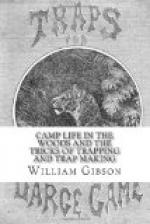[Illustration]
The usual mode of catching the creature is to set the trap size No. 3 at the mouth of its burrow, carefully covering it with loose earth and securing it by a chain to a stake. Any of the methods used in trapping the fox will also be found to work admirably. The dead-fall or garrote will also do good service. Bait with a rat, mouse, or with whatever else the animal is especially fond, and scent with Oil of Anise or Musk. In early spring, while the ground is still hard, badgers are easily captured by flooding their burrows. After being satisfied that the animal is in its hole, proceed to pour in pailful after pailful of water at the entrance. [Page 177] He will not long be able to stand this sort of thing, and he may be secured as he makes his exit at the opening of the burrow.
The skin should be removed whole, as in the case of the fox, or as described for the beaver, and stretched as therein indicated.
THE BEAVER.
The Beaver of North America has now a world-wide reputation for its wonderful instinct and sagacity. The general appearance of this animal is that of a very large muskrat with a broad flattened tail, and the habits of both these animals are in many respects alike. The beaver is an amphibious creature and social in its habits of living, large numbers congregating together and forming little villages, and erecting their dome-like huts like little Esquimaux. The muskrat has this same propensity, but the habitation of the beaver is on a much more extensive scale. These huts or “Beaver lodges,” are generally made in rivers and brooks; although sometimes in lakes or large ponds. They are chiefly composed of branches, moss, grass and mud, and are large enough to accommodate a family of five or six. The form of the “lodges”




